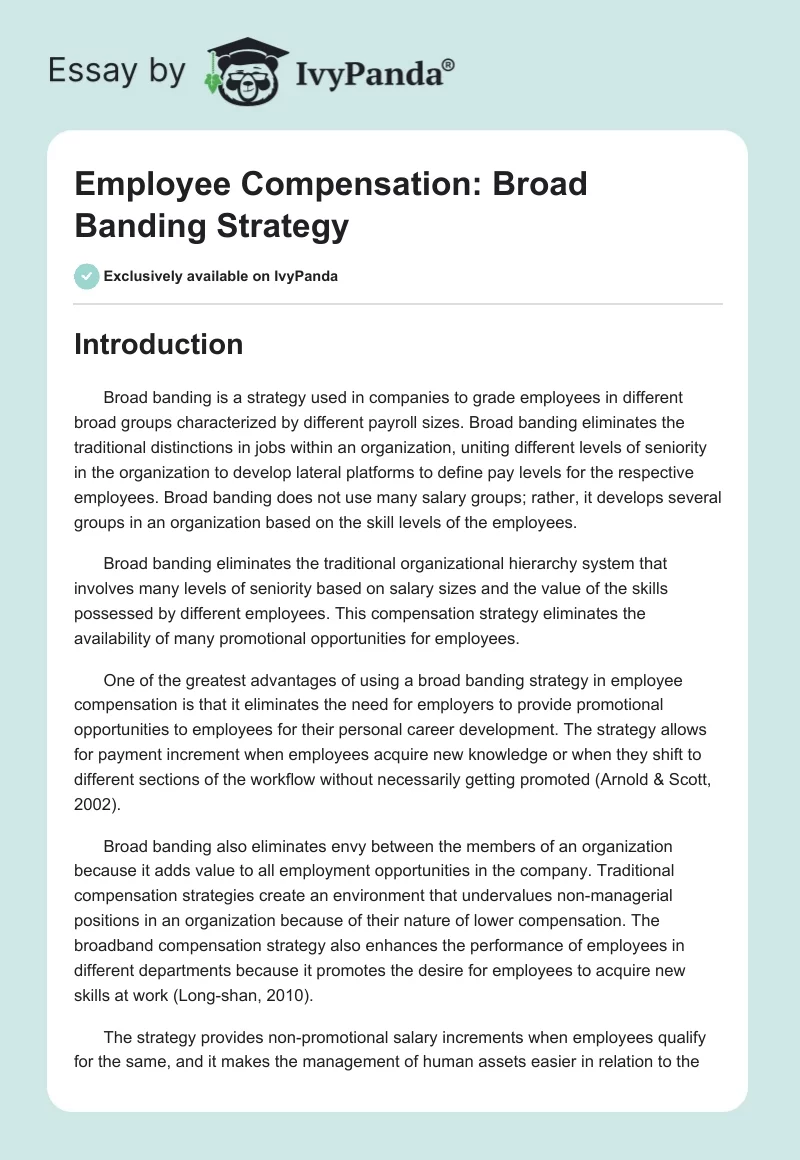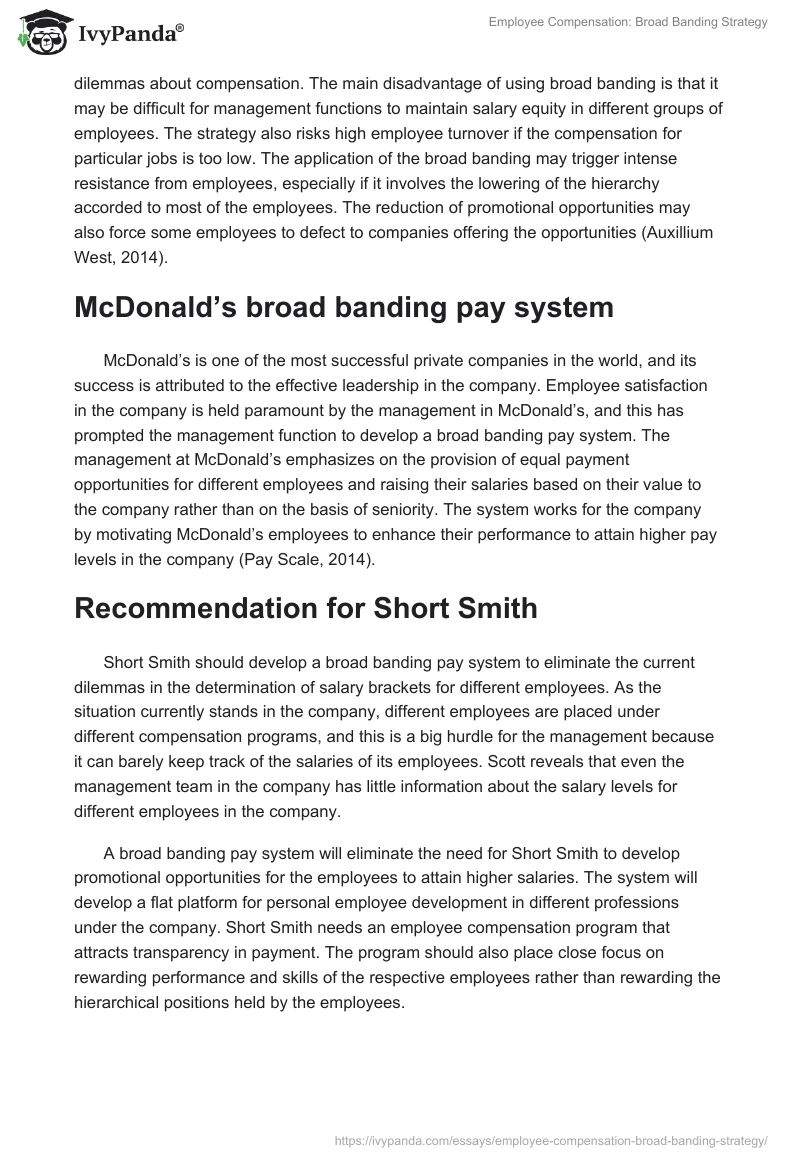Introduction
Broad banding is a strategy used in companies to grade employees in different broad groups characterized by different payroll sizes. Broad banding eliminates the traditional distinctions in jobs within an organization, uniting different levels of seniority in the organization to develop lateral platforms to define pay levels for the respective employees. Broad banding does not use many salary groups; rather, it develops several groups in an organization based on the skill levels of the employees.
Broad banding eliminates the traditional organizational hierarchy system that involves many levels of seniority based on salary sizes and the value of the skills possessed by different employees. This compensation strategy eliminates the availability of many promotional opportunities for employees.
One of the greatest advantages of using a broad banding strategy in employee compensation is that it eliminates the need for employers to provide promotional opportunities to employees for their personal career development. The strategy allows for payment increment when employees acquire new knowledge or when they shift to different sections of the workflow without necessarily getting promoted (Arnold & Scott, 2002).
Broad banding also eliminates envy between the members of an organization because it adds value to all employment opportunities in the company. Traditional compensation strategies create an environment that undervalues non-managerial positions in an organization because of their nature of lower compensation. The broadband compensation strategy also enhances the performance of employees in different departments because it promotes the desire for employees to acquire new skills at work (Long-shan, 2010).
The strategy provides non-promotional salary increments when employees qualify for the same, and it makes the management of human assets easier in relation to the dilemmas about compensation. The main disadvantage of using broad banding is that it may be difficult for management functions to maintain salary equity in different groups of employees. The strategy also risks high employee turnover if the compensation for particular jobs is too low. The application of the broad banding may trigger intense resistance from employees, especially if it involves the lowering of the hierarchy accorded to most of the employees. The reduction of promotional opportunities may also force some employees to defect to companies offering the opportunities (Auxillium West, 2014).
McDonald’s broad banding pay system
McDonald’s is one of the most successful private companies in the world, and its success is attributed to the effective leadership in the company. Employee satisfaction in the company is held paramount by the management in McDonald’s, and this has prompted the management function to develop a broad banding pay system. The management at McDonald’s emphasizes on the provision of equal payment opportunities for different employees and raising their salaries based on their value to the company rather than on the basis of seniority. The system works for the company by motivating McDonald’s employees to enhance their performance to attain higher pay levels in the company (Pay Scale, 2014).
Recommendation for Short Smith
Short Smith should develop a broad banding pay system to eliminate the current dilemmas in the determination of salary brackets for different employees. As the situation currently stands in the company, different employees are placed under different compensation programs, and this is a big hurdle for the management because it can barely keep track of the salaries of its employees. Scott reveals that even the management team in the company has little information about the salary levels for different employees in the company.
A broad banding pay system will eliminate the need for Short Smith to develop promotional opportunities for the employees to attain higher salaries. The system will develop a flat platform for personal employee development in different professions under the company. Short Smith needs an employee compensation program that attracts transparency in payment. The program should also place close focus on rewarding performance and skills of the respective employees rather than rewarding the hierarchical positions held by the employees.
Conclusion
Managing the recommended change in the employee compensation system at Short Smith is expected to be quite difficult because the management has to development of broad hierarchical groups. The main challenge in the system would be placing the current employees in similar pay brackets without experiencing resistance. The lateral approach to seniority that associates with the broad banding approach can help in the elimination of these challenges. Demoting some of the current employees to their rightful seniority groups may attract turnovers in the company (Carraher, 2011). The management should develop change management strategies to make the transition period smoother.
Payment system of choice
A comprehensive compensation system that involves a base salary with several attached benefits, including health care coverage is the best for the employees. The system fosters higher satisfaction and the subsequent motivation to employees is an added advantage to the companies offering such compensation systems (Carraher, 2011). A payment system that takes health benefits for employees into consideration is always more enticing for employees; hence, it would be better than a system that pays a larger amount without health benefits and paid personal time. Employee compensation should increase their financial security (Porter & Kramer, 2011).
References
Arnold, E. W., & Scott, C. J. (2002). Does broad banding improve pay system effectiveness. Southern Business Review, 27(2), 1-8.
Auxillium West: Broad banding. (2014). Web.
Carraher, S. M. (2011). Turnover prediction using attitudes towards benefits, pay, and pay satisfaction among employees and entrepreneurs in Estonia, Latvia, and Lithuania. Baltic Journal of Management, 6(1), 25-52.
Long-shan, K. E. (2010). A prudent consideration of introducing broad banding to official salary Management. Journal of Changchun Institute of Technology (Social Sciences Edition), 2, 021.
Pay Scale: Average Salary for McDonald’s Corporation Employees. (2014). Web.
Porter, M. E., & Kramer, M. R. (2011). Creating shared value. Harvard business review, 89(1/2), 62-77.

 4.00
4.00
